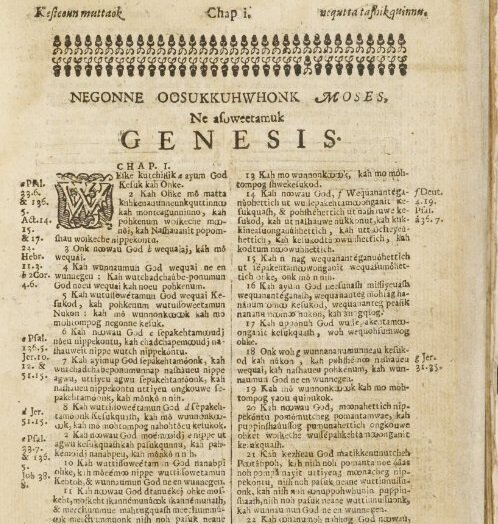
The current Eliot Church in South Natick is the fifth house of worship to stand on that spot since 1651.
The Eliot Church
In 1651, dozens of Massachusett people living in Nonantum under Waban’s leadership moved to South Natick to live in the first “Praying Town.” Shortly after, they, along with Reverend John Eliot, established a church in South Natick on a well-traveled path we now call Eliot Street. The neat white church you see there today is the fifth building on that site, where people have worshiped for almost 375 years.
The first meeting house was erected in 1652 and was “built after the English manner…the lower room is a large hall…the upper room is a kind of wardrobe, where the Indians hang up their skins and other things of value. In a corner of this room Mr. Eliot has an apartment…with a bed…” It lasted about 50 years, surviving Eliot who died in 1690.
In 1702, John Collar Jr., an English carpenter, built a new meetinghouse on the site and received 200 acres of land in payment. During the next 20 years, the “Praying Indian” community and its church were in decline, despite the efforts of Rev. Daniel Takawambpait, the first ordained Indigenous minister, and other Algonquian leaders who had some assistance from neighboring English ministers like Daniel Gookin Jr. and Daniel Baker. Unfortunately, there are no surviving sketches or descriptions of what this church looked like.
In 1721 a Harvard College graduate, 23-year-old Oliver Peabody, was assigned to the Natick congregation, and a third church structure was built to replace the meetinghouse that was in ruin, with shattered siding and broken windows. There are no surviving authentic images of the third church.
The “Eliot Oak,” with the church building behind it.
Rev. Stephen Badger, another young Harvard graduate, was ordained in 1753 and appointed to lead the South Natick church. Construction of the fourth meetinghouse was soon underway. In her 1869 book, Oldtown Folks (it was loosely based on real people in South Natick), Harriet Beecher Stowe described the “meeting-house” as “one of those huge shapeless, barn-like structures…two staring rows of windows, which let in the glare of the summer sun, and which were so loosely framed, that, in wintry and windy weather, they rattled and shook, and poured in a perfect whirlwind of cold air…”
The meetinghouse that now stands at 45 Eliot Street was built in 1828 for the South Congregational Society of Natick, in the newly formed South Parish. Nearby trees were cut for timber, and the new church bell was cast in Medway by G. H. Holbrook, who had been an apprentice to Paul Revere. At the time, the building had oil lamps for lighting and a wood stove, but, alas, no indoor plumbing. Nearby stood the reputed “Eliot Oak,” a white oak tree that may have shaded Eliot when he did his earliest preaching to Native people in the mid-17th century.
Selected sources and additional reading:
Natick Historical Society collections.
Gookin, Daniel. Historical Collections of the Indians in New England. 1792. Reprint, Towtaid, 1970.
Gookin, Daniel. Historical Collections of the Indians in New England, 1674.
Morley, James W. From Many Backgrounds: The Heritage of the Eliot Church of South Natick. South Natick, MA: The Natick Historical Society, 2007.




